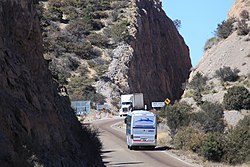Janos | |
|---|---|
 | |
| Motto(s): Primero México, Después México, Siempre México (First Mexico, Then Mexico, Always Mexico) | |
 Location of Janos in Chihuahua | |
| Coordinates: 30°53′16″N108°11′24″W / 30.88778°N 108.19000°W | |
| Country | |
| State | Chihuahua |
| Municipality | Janos |
| Mission established | 1640 |
| Presidio established | 1686 |
| Municipality created | 1820 |
| Founded by | Franciscan missionaries |
| Named after | Janos people |
| Government | |
| • Municipal President | Leonel Molina García (PRI) |
| Area (municipality) | |
• Total | 6,930.50 km2 (2,675.88 sq mi) |
| Elevation | 1,369 m (4,491 ft) |
| Population (2010) | |
• Total | 10,953 |
| Postal code | 31840 |
| Area code | 636 |
| Website | http://www.janos.gob.mx |
Janos is a municipality in the Mexican state of Chihuahua. It is located in the extreme northwest of Chihuahua, on the border with the state of Sonora and the U.S. states of Arizona and New Mexico. As of 2010, the municipality had a total population of 10,953. [1] The municipal seat is the town of Janos, Chihuahua, which shares its name with the municipality.
Contents
The El Berrendo/Antelope Wells border crossing is located in the municipality.
As of 2010, the town of Janos had a population of 2,738. [1] Other than the town of Janos, the municipality had 315 localities, the largest of which (with 2010 populations in parentheses) was: Monte Verde (Altamira) (1,087), classified as rural. [1]
The name "Janos" was given by the Janos people, the indigenous inhabitants of the area upon the arrival of the Spaniards. [2] The Janos were probably a sub-tribe or closely related to the Suma people. Neither the Janos nor the Suma survived contact and are now extinct. Franciscan missionaries originally built a mission in the location in 1640, under the name Soledad de Janos. The mission did not, however, survive a series of revolts by indigenous people and was replaced on 16 October 1686 by a military presidio under Gen. Juan Fernández de la Fuente. The presidio defended the area from attacks from Apache raiders until the municipality was established in 1820.

